 |
Convert MPEG to AMR
|
Total Audio MP3 Converter converts MPEG files to AMR format.
The software is an all in one audio converter that supports more than 90 audio
and video files as input, and converts to popular formats such as MP3, WAV, AAC,
M4A, OGG, WMA, and AMR.
Total Audio MP3 Converter also supports batch conversion, and is full compatible
with Vista and Windows
7.
- Free Download
Total Audio MP3 Converter here and then install the software
by instructions
- Launch Total Audio MP3 Converter
- Choose MPEG Files
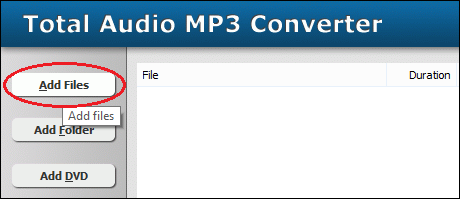
Click "Add Files" to choose MPEG files and then add them to conversion
list.
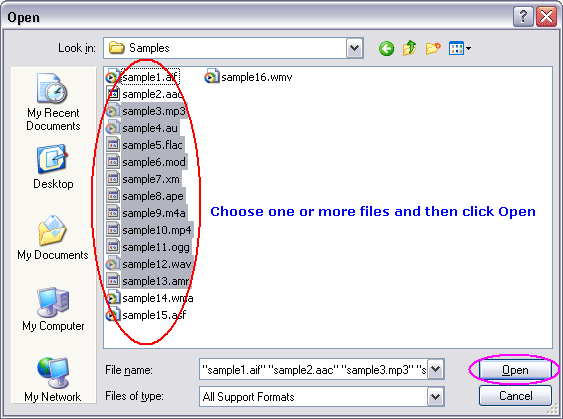
Choose one or more MPEG files you want to convert and then click Open.
- Choose "to AMR"
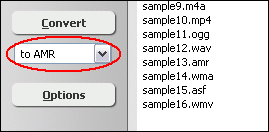
- Convert MPEG to AMR
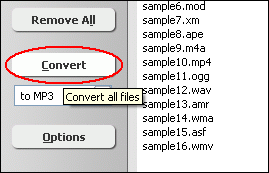
Click button "Convert" to convert all MPEG files to AMR format.
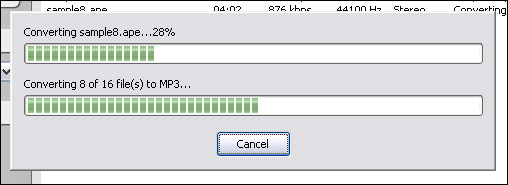
The software is converting MPEG files to AMR format.
- Play & Browse
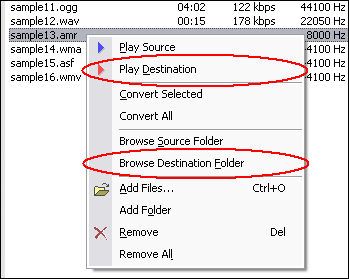
When conversion completes, you could right-click converted item and choose "Play
Destination" to play the destination file; or choose "Browse Destination
Folder" to open Windows Explorer to browse the destination file.
Top
What is MPEG?
The Moving Picture Experts Group (MPEG) was formed by the ISO to set standards
for audio and video compression and transmission. Its first meeting was in May
1988 in Ottawa, Canada. As of late 2005, MPEG has grown to include approximately
350 members per meeting from various industries, universities, and research institutions.
MPEG's official designation is ISO/IEC JTC1/SC29 WG11.
The MPEG standards consist of different Parts. Each part covers a certain aspect
of the whole specification. The standards also specify Profiles and Levels. Profiles
are intended to define a set of tools that are available, and Levels define the
range of appropriate values for the properties associated with them. MPEG has
standardized the following compression formats and ancillary standards:
- MPEG-1: The first compression standard for audio and video. It was
basically designed to allow moving pictures and sound to be encoded into the bitrate
of a Compact Disc. To meet the low bit requirement, MPEG-1 downsamples the images,
as well as uses picture rates of only 24-30 Hz, resulting in a moderate quality.
It includes the popular Layer 3 (MP3) audio compression format.
- MPEG-2: Transport, video and audio standards for broadcast-quality
television. MPEG-2 standard was considerably broader in scope and of wider appeal
- supporting interlacing and high definition. MPEG-2 is considered important because
it has been chosen as the compression scheme for over-the-air digital television
ATSC, DVB and ISDB, digital satellite TV services like Dish Network, digital cable
television signals, SVCD, and DVD.
- MPEG-3: Developments in standardizing scalable and multi-resolution
compression which would have become MPEG-3 were ready by the time MPEG-2 was to
be standardized; hence, these were incorporated into MPEG-2 and as a result there
is no MPEG-3 standard. MPEG-3 is not to be confused with MP3, which is MPEG-1
Audio Layer 3.
- MPEG-4: MPEG-4 uses further coding tools with additional complexity
to achieve higher compression factors than MPEG-2. In addition to more efficient
coding of video, MPEG-4 moves closer to computer graphics applications. In more
complex profiles, the MPEG-4 decoder effectively becomes a rendering processor
and the compressed bitstream describes three-dimensional shapes and surface texture.
MPEG-4 also provides Intellectual Property Management and Protection (IPMP) which
provides the facility to use proprietary technologies to manage and protect content
like digital rights management. Several new higher-efficiency video standards
(newer than MPEG-2 Video) are included (an alternative to MPEG-2 Video), notably:
- MPEG-4 Part 2 (or Simple and Advanced Simple Profile) and
- MPEG-4 AVC (or MPEG-4 Part 10 or H.264). MPEG-4 AVC may be used on
HD DVD and Blu-ray discs, along with VC-1 and MPEG-2.
In addition, the following standards, while not sequential advances to the
video encoding standard as with MPEG-1 through MPEG-4, are referred to by similar
notation:
- MPEG-7: A multimedia content description standard.
- MPEG-21: MPEG describes this standard as a multimedia framework.
Moreover, relatively more recently than other standards above, MPEG has started
following international standards; each of the standards holds multiple MPEG technologies
for a way of application. For example, MPEG-A includes a number of technologies
on multimedia application format.
- MPEG-A: Multimedia application format.
- MPEG-B: MPEG systems technologies.
- MPEG-C: MPEG video technologies.
- MPEG-D: MPEG audio technologies.
- MPEG-E: Multimedia Middleware.
What is AMR?
Adaptive Multi-Rate (AMR) is an audio data compression scheme optimized for speech
coding. AMR was adopted as the standard speech codec by 3GPP in October 1998 and
is now widely used in GSM and UMTS. It uses link adaptation to select from one
of eight different bit rates based on link conditions. AMR is also a file format
for storing spoken audio using the AMR codec. Many modern mobile telephone handsets
will allow you to store short recordings in the AMR format. There also exists
another storage format for AMR that is suitable for applications with more advanced
demands on the storage format, like random access or synchronization with video.
This format is the 3GPP-specified 3GP container format based on ISO base media
file format.
Key Features:
- Sampling frequency 8 kHz/13-bit (160 samples for 20 ms frames), filtered to
200-3400 Hz.
- The AMR codec uses eight source codecs with bit-rates of 12.2, 10.2, 7.95,
7.40, 6.70, 5.90, 5.15 and 4.75 kbit/s.
- Generates frame length of 95, 103, 118, 134, 148, 159, 204, or 244 bits for
bit rates 4.75, 5.15, 5.90, 6.70, 7.40, 7.95, 10.2, or 12.2 kbit/s, respectively
- AMR utilizes Discontinuous Transmission (DTX), with Voice Activity Detection
(VAD) and Comfort Noise Generation (CNG) to reduce bandwidth usage during silence
periods
- Algorithmic delay is 20 ms per frame. For bit-rates of 12.2, there is no 'algorithm'
look-ahead delay. For other rates, look-ahead delay is 5 ms. Note that there is
5 ms 'dummy' look-ahead delay, to allow seamless frame-wise mode switching with
the rest of rates.
- AMR is a hybrid speech coder which uses Algebraic Code Excited Linear Prediction
(ACELP)
- The complexity of the algorithm is rated at 5, using a relative scale where
G.711 is 1 and G.729a is 15.
- PSQM testing under ideal conditions yields Mean Opinion Scores of 4.14 for
AMR (12.2 kbit/s), compared to 4.45 for G.711 (u-law)
- PSQM testing under network stress yields Mean Opinion Scores of 3.79 for AMR
(12.2 kbit/s), compared to 4.13 for G.711 (u-law)
Convert MPEG to AMR Related Topics:
3GP2 to AMR,
WV to AMR,
GSM to AMR,
QCP to AMR,
APE to AMR,
ROQ to AMR,
ALAC to AMR,
AMR to AWB,
OGM to AMR,
MOV to AMR,
ULAW to AMR,
AMV to AMR,
MTM to AMR,
MMF to AMR,
DV to AMR,
3G2 to AMR,
DXA to AMR,
AMR to WAV,
EVOB to AMR,
NUV to AMR,
AMR to AAC,
OMA to AMR,
AMR to M4A,
MTS to AMR,
CAF to AMR,
ALAW to AMR,
MPGA to AMR,
WMD to AMR,
TTA to AMR,
MP1 to AMR,
NUT to AMR,
FLIC to AMR,
XA to AMR,
4XM to AMR,
QT to AMR,
ASF to AMR,
F4A to AMR,
AVI to AMR,
M4A to AMR,
PVA to AMR
|






